


ORGANS OF PARIS © 2024 Vincent Hildebrandt HOME ALL ORGANS


Saint Séverin dates back to the end of the 11th
century, built on the place of a former chapel (VIth
century). The clocktower dates to 1412. Its present
appearance in flamboyant Gothic style dates back
to the 15-17th century.
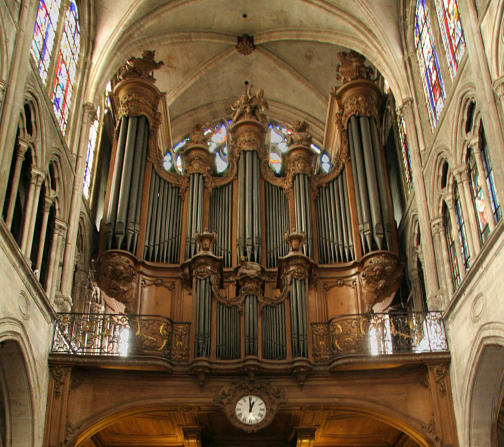
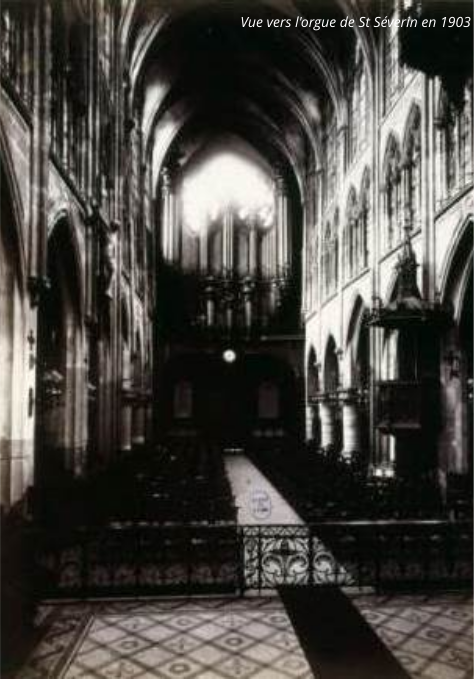
Drawing of the organ, 1860
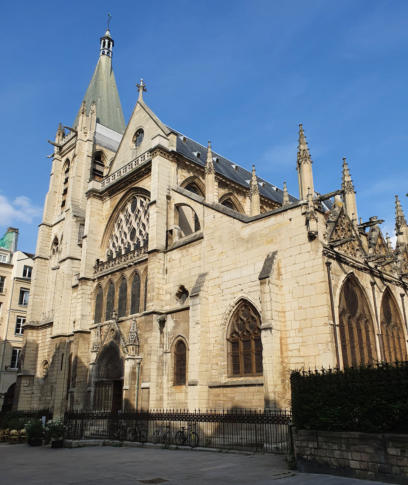
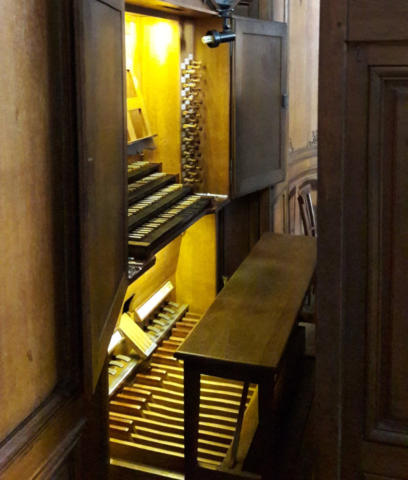
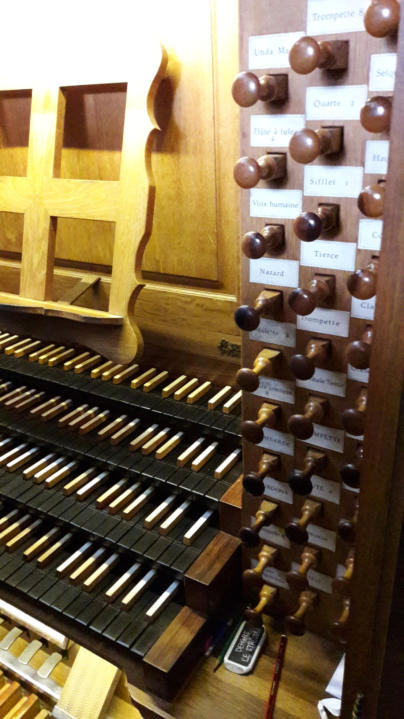
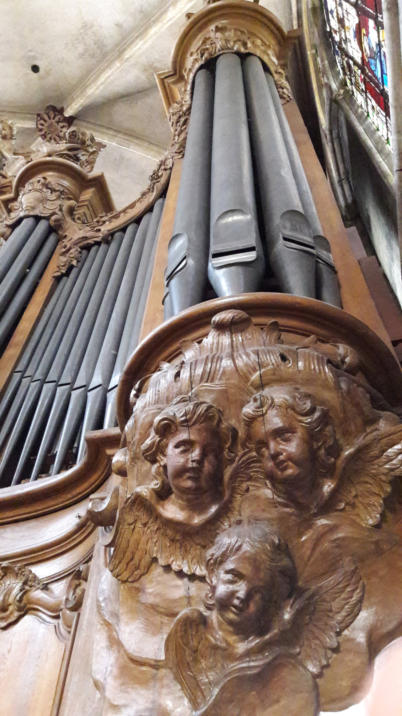
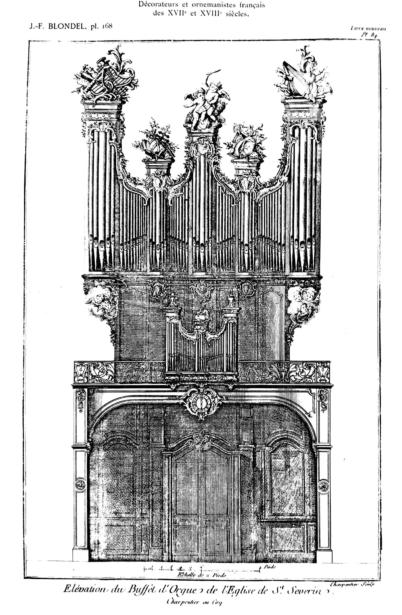
1748 - Claude Ferrand (1)
1825 - Pierre-François Dallery (5)
1889 - John Abbey (3a)
1963 - Alfred Kern (3)
1982 - Daniel Kern (6)
1988 - Dominique Lalmand (6)
2011 - Quentin Blumenroeder (5)
IV/59 - traction mécanique
composition
A2
The church of Saint-Séverin had an organ as early as the 14th
century, which was replaced in the 16th century by the organ
builder Valeran de Héman. Enlarged by Charles and Alexandre
Thierry in the years 1670-1673, it was replaced by a new
instrument in 1745. The instrument was then in a state of
total disrepair, eaten away by rats and rust.
1745
The creation of the beautiful oak sideboard, in the Louis XV
style, was entrusted to the carpenter François Dupré and
Jacques-François Fichon, for the execution of the sculptures.
Organ builder Claude Ferrand provided a new instrument
using some old stops. This "tall 16-footer" was considered one
of the most beautiful in the capital.
1825
Although the organ survived the French Revolution without
incident, the elder Dallery sent a memorandum on 21 Oct.
1825 stating that "the organ is in such a state of decay that it
threatens your interests and public safety." A restoration
followed. Dallery redid the reeds as well as the feet and
badges of the Grande Montre.
A basic repair was carried out in 1850.
1889
Organ builder Abbey was commissioned to rebuild the organ.
Only 25 stops were reused. Abbey completely rebuilt the
instrument in the symphonic style: windchests, wind tunnel
and action were rebuilt. The emptied Positive received the
new detached console. The organ was completely revoiced. At
that time, the instrument had 36 stops on three manuals and
pedalboard
1963-1964
The construction of the new instrument was entrusted to the
organ builder Alfred Kern. The design of the organ was to be a
synthesis between the French Classical Organ and the
Germanic Organ:
•
The Back Positive returns to its original function.
•
a Resonance division is created, complementary to the
Great and the Pedal
•
in the main case, on the ground floor, were placed, on
either side of the mechanical block, the two windchests of
the Echo, the base serving as an expressive box.
•
Abbey's windchests and wind tunnel were reused, as well
as 26 old stops and 10 Abbey stops. Abbey's stops and the
old ones modified by him in 1889 were restored according
to the classical style.
•
Germanic mixtures and a Germanic Third Cymbal took
their place alongside the nine rows of an "alla Dom Bedos"
Plein Jeu.
•
The old-fashioned (suspended) mechanism was designed
by Philippe Hartmann and Alfred Kern.
•
A new window console was built.
1970
In the 1970s, changes were made to the layout, possibly by
the Kern House.
•
The 16' Resonance Musette replaced the G.O.'s 16'
Bombarde while being shifted to 8'.
•
The 4' Oboe of Résonnance was moved to 8'.
1982
Daniel Kern made a few changes:
•
The Quintaton 8' of the Positif was placed at the
Resonance keyboard.
•
The Echo's 8' old Trumpet found its place at the Positif
•
In the Echo, the 4' Clairon was changed to the 8' Trumpet
and a 1' Sifflet was added.
1988
Dominique Lalmand proceeded to a revision of the power
supply, to adjust the calls of reeds and mixtures, and of the
mechanisms of the various manuals, and to revoicing the
Plein-Jeu of the positif.
2011
A major restoration of the instrument was carried out by
Quentin Bluenroeder in collaboration with the Thomas Organ
Factory. The reeds were all harmonized by Jean-Marie
Tricoteaux. These builders respected the work and spirit of
Alfred Kern, while maintaining the modifications made in 1970
and 1982.
St Séverin is also emblematic for the liturgy. Since the Second
Vatican Council, St. Severin has become widely known thanks to
his exceptional liturgy performed by Michel Chapuis and Father
Duchesnau.
The latter largely favors the place of the organ and the
participation of the assembly, as required by the constitution
"Sacrosanctum Concilium" of Vatican II. Enriched over the years,
this repertoire gives a large place to the Lutheran chorale and the
Huguenot Psalter, while retaining the Gregorian translated into
the vernacular.
Organistes titulaires
François Espinasse, Nicolas Bucher, Christophe
Mantoux, Véronique Le Guen.
Famous organists in the past: Nicolas Séjan,
Camille Saint-Saëns, Michel Chapuis.
Concerts
Regularly on Saturdays
Masses with organ
Vêpres Saturday 6:00 PM,
Masses at 10:30 and 12:00 AM, 7:30 PM.
Videos
Christophe Mantoux
Michel Alabau (former co-titulaire).
All organs built before the revolution
Photo case: Jeroen de Haan
Other photos : Victor Weller

The organs of Paris
ORGANS OF PARIS © 2024 Vincent Hildebrandt ALL ORGANS
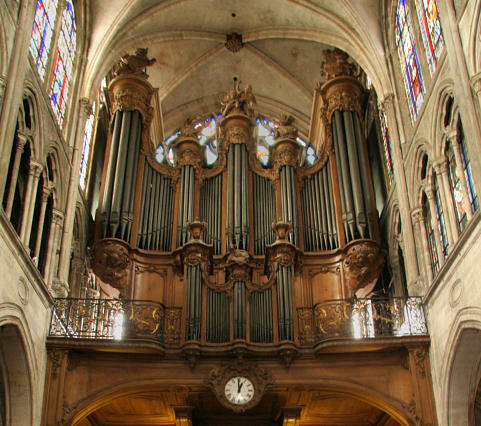
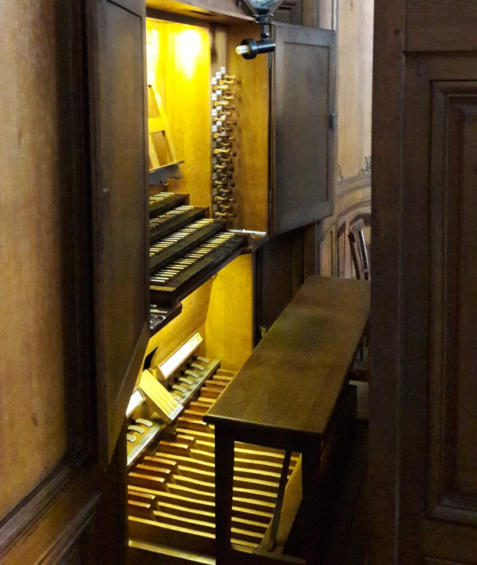
1748 - Claude Ferrand (1)
1825 - Pierre-François Dallery (5)
1889 - John Abbey (3a)
1963 - Alfred Kern (3)
1982 - Daniel Kern (6)
1988 - Dominique Lalmand (6)
2011 - Quentin Blumenroeder (5)
IV/59 - traction mécanique
composition
A2
The church of Saint-Séverin had an organ as early as the 14th
century, which was replaced in the 16th century by the organ
builder Valeran de Héman. Enlarged by Charles and Alexandre
Thierry in the years 1670-1673, it was replaced by a new
instrument in 1745. The instrument was then in a state of
total disrepair, eaten away by rats and rust.
1745
The creation of the beautiful oak sideboard, in the Louis XV
style, was entrusted to the carpenter François Dupré and
Jacques-François Fichon, for the execution of the sculptures.
Organ builder Claude Ferrand provided a new instrument
using some old stops. This "tall 16-footer" was considered one
of the most beautiful in the capital.
1825
Although the organ survived the French Revolution without
incident, the elder Dallery sent a memorandum on 21 Oct.
1825 stating that "the organ is in such a state of decay that it
threatens your interests and public safety." A restoration
followed. Dallery redid the reeds as well as the feet and
badges of the Grande Montre.
A basic repair was carried out in 1850.
1889
Organ builder Abbey was commissioned to rebuild the organ.
Only 25 stops were reused. Abbey completely rebuilt the
instrument in the symphonic style: windchests, wind tunnel
and action were rebuilt. The emptied Positive received the
new detached console. The organ was completely revoiced. At
that time, the instrument had 36 stops on three manuals and
pedalboard
1963-1964
The construction of the new instrument was entrusted to the
organ builder Alfred Kern. The design of the organ was to be a
synthesis between the French Classical Organ and the
Germanic Organ:
•
The Back Positive returns to its original function.
•
a Resonance division is created, complementary to the
Great and the Pedal
•
in the main case, on the ground floor, were placed, on
either side of the mechanical block, the two windchests of
the Echo, the base serving as an expressive box.
•
Abbey's windchests and wind tunnel were reused, as well
as 26 old stops and 10 Abbey stops. Abbey's stops and the
old ones modified by him in 1889 were restored according
to the classical style.
•
Germanic mixtures and a Germanic Third Cymbal took
their place alongside the nine rows of an "alla Dom Bedos"
Plein Jeu.
•
The old-fashioned (suspended) mechanism was designed
by Philippe Hartmann and Alfred Kern.
•
A new window console was built.
1970
In the 1970s, changes were made to the layout, possibly by
the Kern House.
•
The 16' Resonance Musette replaced the G.O.'s 16'
Bombarde while being shifted to 8'.
•
The 4' Oboe of Résonnance was moved to 8'.
1982
Daniel Kern made a few changes:
•
The Quintaton 8' of the Positif was placed at the
Resonance keyboard.
•
The Echo's 8' old Trumpet found its place at the Positif
•
In the Echo, the 4' Clairon was changed to the 8' Trumpet
and a 1' Sifflet was added.
1988
Dominique Lalmand proceeded to a revision of the power
supply, to adjust the calls of reeds and mixtures, and of the
mechanisms of the various manuals, and to revoicing the
Plein-Jeu of the positif.
2011
A major restoration of the instrument was carried out by
Quentin Bluenroeder in collaboration with the Thomas Organ
Factory. The reeds were all harmonized by Jean-Marie
Tricoteaux. These builders respected the work and spirit of
Alfred Kern, while maintaining the modifications made in 1970
and 1982.
St Séverin is also emblematic for the liturgy. Since the Second
Vatican Council, St. Severin has become widely known thanks to
his exceptional liturgy performed by Michel Chapuis and Father
Duchesnau.
The latter largely favors the place of the organ and the
participation of the assembly, as required by the constitution
"Sacrosanctum Concilium" of Vatican II. Enriched over the years,
this repertoire gives a large place to the Lutheran chorale and the
Huguenot Psalter, while retaining the Gregorian translated into
the vernacular.
Organistes titulaires
François Espinasse, Nicolas Bucher, Christophe Mantoux,
Véronique Le Guen.
Famous organists in the past: Nicolas Séjan, Camille Saint-Saëns,
Michel Chapuis.
Concerts
Regularly on Saturdays
Masses with organ
Vêpres Saturday 6:00 PM,
Masses at 10:30 and 12:00 AM, 7:30 PM.
Videos
Christophe Mantoux
Michel Alabau (former co-titulaire).
All organs built before the revolution
Photo case: Jeroen de Haan
Other photos : Victor Weller






















